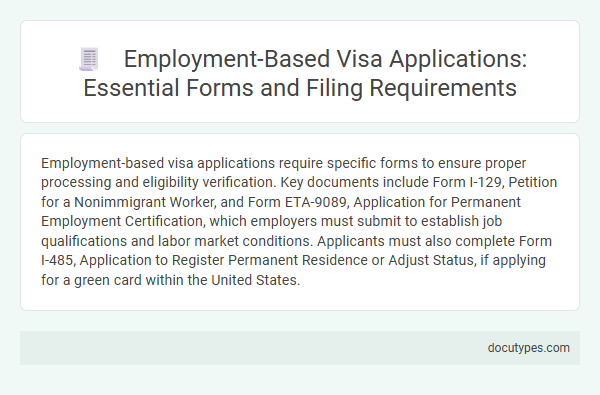Employment-based visa applications require specific forms to ensure proper processing and eligibility verification. Key documents include Form I-129, Petition for a Nonimmigrant Worker, and Form ETA-9089, Application for Permanent Employment Certification, which employers must submit to establish job qualifications and labor market conditions. Applicants must also complete Form I-485, Application to Register Permanent Residence or Adjust Status, if applying for a green card within the United States.
Overview of Employment-Based Visas
```htmlEmployment-based visas allow foreign nationals to work legally in the United States. These visas are classified into several preference categories based on skills, education, and job offers.
Your application will typically require forms such as the Form I-140, Immigrant Petition for Alien Worker. Additional forms include the Form ETA-9089 for labor certification and Form I-485 for adjustment of status.
```Key Eligibility Criteria for Applicants
Employment-based visa applications require specific forms, including Form I-140 (Immigrant Petition for Alien Worker) and Form I-485 (Application to Register Permanent Residence or Adjust Status), depending on the visa category. Key eligibility criteria involve demonstrating a valid job offer, proof of qualifications, and meeting the labor certification requirements when applicable. You must ensure all forms are accurately completed to reflect your employment and eligibility details for a successful application process.
Essential Documentation Checklist
Which forms are required for employment-based visa applications? Employment-based visa applications typically require Form I-140, Immigrant Petition for Alien Worker, and Form ETA-9089, Application for Permanent Employment Certification. Your employer may also need to submit Form I-129 for temporary work visas depending on the visa category.
Form I-140: Immigrant Petition for Alien Worker
Form I-140, Immigrant Petition for Alien Worker, is a critical document in employment-based visa applications. This form establishes the petitioner's ability to employ the foreign worker under U.S. immigration law.
Employers must file Form I-140 to demonstrate the worker's eligibility for permanent residence based on employment. It includes information about the job offer, worker qualifications, and the employer's financial capability to pay the wage.
PERM Labor Certification Process
The PERM Labor Certification process is a critical step for most employment-based visa applications, proving that no qualified U.S. workers are available for the job. Specific forms must be completed and submitted to the Department of Labor to initiate and complete this process.
- ETA Form 9089 - The official Application for Permanent Employment Certification, submitted electronically or by mail to the Department of Labor.
- Recruitment Documentation - Evidence of recruitment efforts used to test the U.S. labor market, required to demonstrate compliance with regulatory standards.
- Prevailing Wage Determination Request - Request submitted to the National Prevailing Wage Center to establish the minimum wage for the offered position based on geographic and occupational data.
Filing Form I-485: Adjustment of Status
Filing Form I-485, Adjustment of Status, is a crucial step in the employment-based visa application process. This form allows applicants already in the United States to apply for permanent residency without leaving the country. Supporting documents such as the approved Form I-140, medical examination, and proof of lawful entry must accompany the application.
Required Supporting Evidence
| Form Name | Purpose | Required Supporting Evidence |
|---|---|---|
| I-140, Immigrant Petition for Alien Worker | Petition filed by employer to classify foreign worker under an employment-based visa category | Labor certification approval or attestation from the Department of Labor; Evidence of the petitioner's ability to pay the offered wage; Proof of the beneficiary's qualifications, including degrees, licenses, and work experience |
| I-485, Application to Register Permanent Residence or Adjust Status | Application to adjust status to permanent resident within the United States | Copy of the approved I-140 petition; Medical examination report (Form I-693); Proof of lawful entry; Evidence of maintaining lawful status; Two passport-style photos |
| G-28, Notice of Entry of Appearance | Form used to notify USCIS that an attorney or accredited representative will represent you | Signed authorization by the applicant or petitioner |
| ETA Form 9089, Application for Permanent Employment Certification | Application submitted to the Department of Labor for labor certification | Documentation of recruitment efforts; Employer's business necessity; Wage determination evidence; Employer's financial statements |
| I-765, Application for Employment Authorization | Application to request employment authorization while the visa application is pending | Copy of the receipt notice for I-485 or I-140; Passport-style photos; Evidence of eligibility under visa category |
Filing Fees and Payment Procedures
Employment-based visa applications require specific forms that must be filed with the correct fees to avoid processing delays. Understanding the payment procedures for these forms is essential for a smooth application process.
- Form I-140, Immigrant Petition for Alien Worker - This form requires a filing fee of $700, payable to the U.S. Department of Homeland Security.
- Form I-485, Application to Register Permanent Residence or Adjust Status - Filing fees vary by age and category but generally range from $750 to $1,140, including biometrics fees when applicable.
- Payment Methods - Fees can be paid by check, money order, or credit card; ensure the payment matches the exact fee amount and follows USCIS guidelines.
Common Mistakes and How to Avoid Them
Employment-based visa applications require specific forms such as Form I-140, Immigrant Petition for Alien Worker, and Form ETA-9089, Application for Permanent Employment Certification. Understanding the correct forms is crucial to avoid processing delays or rejections.
Common mistakes include submitting incomplete forms, incorrect fee payments, and missing supporting documents. To avoid these issues, ensure all information is accurate and double-check each section before submission. Keeping a checklist of required documents can help maintain organization and prevent errors in Your application process.
Which Forms Are Required for Employment-Based Visa Applications? Infographic

